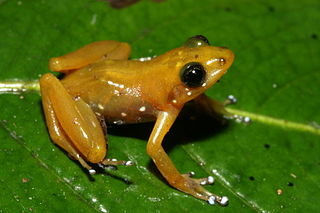
The Mantellidae are a family of the order Anura. These frogs are endemic to the islands of Madagascar and Mayotte.

Scaphiophryne gottlebei, commonly known as the Malagasy rainbow frog, ornate hopper, rainbow burrowing frog, red rain frog or Gottlebe's narrow-mouthed frog, is one of the most highly decorated frogs from Madagascar. The primary threats to this endangered species are habitat loss and capture for the pet trade.

Boophis is the only genus in the mantellid frog subfamily Boophinae. They are commonly known as bright-eyed or skeleton frogs. They show typical 'tree frog' traits, and are a good example of convergent evolution with morphologically similar species in the families Hylidae and Rhacophoridae, among others. This genus can only be found on Madagascar and Mayotte Island (Comoros).

Boophis brachychir is a species of frog in the family Mantellidae.

Boophis elenae is a species of frog in the family Mantellidae. It is endemic to Madagascar, known only from Ranomafana National Park and Farimazava Forest in Antoetra. Its natural habitats are subtropical or tropical moist lowland forests, subtropical or tropical moist montane forests, rivers, arable land, plantations, rural gardens, and heavily degraded former forest. It is threatened by habitat loss for agriculture, timber extraction, charcoal manufacturing, invasive eucalyptus, livestock grazing and expanding human settlements.
Boophis feonnyala is a species of frogs in the family Mantellidae.

Boophis goudotii is a species of frog in the family Mantellidae. It is endemic to Madagascar where it is widespread on the high plateau of central Madagascar. Records elsewhere are uncertain and many of them represent misidentifications. It is the only Malagasy frog where females are known to be vocal.

Boophis occidentalis is a species of frog in the family Mantellidae. It is endemic to Madagascar. Its natural habitats are subtropical or tropical dry forests, rivers, pastureland, urban areas, and heavily degraded former forest. It is threatened by habitat loss.

Boophis rhodoscelis is a species of frog in the family Mantellidae.

The green bright-eyed frog is a species of frog in the family Mantellidae. It is endemic to Madagascar.

Mantella baroni is a species of small poisonous frog in the family Mantellidae.

The blue-legged mantella is a small species of frog in the family Mantellidae. It is endemic to the Isalo National Park and areas south of it in Madagascar, a range it shares with the rainbow frog. Both are locally common, but endangered due to habitat loss and over-collected for the pet trade.

Mantella madagascariensis, common names Malagasy painted mantella, Madagascan mantella, Madagascar golden frog, Malagasy mantella and painted mantella, is a species of frog in the family Mantellidae.

Mantidactylus charlotteae is a species of frog in the family Mantellidae. It is endemic to Madagascar and found in the eastern part of the country in the coastal rainforest belt between Marojejy in the north and possibly as far as Andohahela in the south.

The Sahamalaza sportive lemur is a species of sportive lemur endemic to northern Madagascar.

Blommersia angolafa is a species of frogs in the family Mantellidae. This recently described species is endemic to eastern Madagascar. The specific epithet is derived from the term “angolafa” or “angolafo”, which is the Malagasy vernacular name used by the Betsimisaraka people for the Dypsis palm species, whose leaves and prophylls are the habitat for this frog.

Spinomantis brunae is a species of frogs in the family Mantellidae. It is endemic to Madagascar and known from the Anosy Mountains in southeastern Madagascar.

Beddomixalus is a monotypic genus of frogs in the family Rhacophoridae. The only described species, Beddomixalus bijui, is endemic to the Western Ghats, India. Its name is derived from a combination of the cognomen of Richard Henry Beddome, in honour of his work on the amphibian diversity of the Western Ghats, as well as Ixalus, which is often used as a suffix for names of rhacophorid genera.

Boophis popi is a nocturnal species of skeleton frog endemic to the forests of Madagascar. It is characterized by its red irises and distinctly elevated reticulations on the dorsum. It is brown and gray, has slender limbs, has a pulsating call, and is slightly larger than similar frogs in its genus. The species was described in 2011 and is named after the company "pop-interactive GmbH".

Boophis fayi is a nocturnal species of skeleton frog endemic to the forests and wetlands or Madagascar with unusual greenish eyes. It is considered to be vulnerable by the International Union for Conservation of Nature.




















